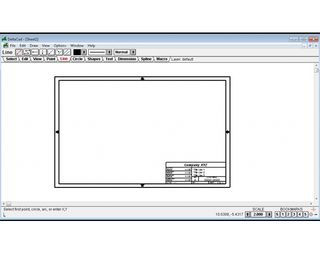

In AD, a 2D drawing is automatically derived from a 3D model. Or not, if you made a mistake in drawing or dimensioning any of the views. Assuming you have enough views and the correct dimensions, there is a fairly good chance you will get what you think you will get the first time around. You can even hand a machinist or a woodworker or carver or model maker a piece of paper and request that a part be made using the information on the drawing. With a piece of paper you can file a copy away to refer to years later when that part needs to be made again. With a piece of paper you can make copies and distribute them around for review and approvals. To my mind that is just great if you need something on paper to define what is going to be carved out of some chunk of metal or plastic or wood or whatever. It basically allows you to “document” a project in the traditional way with various “views” of your design. In AD, a 2D drawing is intended to be a projection onto a plane of a 3D solid object, or a cross-section of that object. In any event, it is the designer’s responsibility to check those things, not the machine shop. That is often difficult to do from a stack of 2D drawings because the physical relationships are not always obvious. They can check dimensions, clearances, and tolerances of fit directly from the 3D model. They will also work from 2D drawings, but I think they much prefer to have a 3D model to start with, especially if a complicated assembly is required.
DELTACAD 3D SOFTWARE
Of course I have to export the model in a file format their software recognizes, but that isn’t a problem with AD Expert.

The machine shop whose services I use works this way. Or they will make a 2D view and print it, if they feel they need it, from your model. Many job shops today will accept your 3D model and not even bother with 2D drawings. It is a leftover from the days before numerically controlled machines existed. The 2D drawing capability in AD is a throwback to the days when machine shops demanded 2D drawings before they would even turn on a lathe or milling machine. DO the built-in tutorials, don’t just read them. Immerse yourself in learning Alibre Design. If you have tried Google SketchUp, forget about that too. Forget everything you know, or think you know, about CAD. Go down this road if you desire, but in my opinion it is not the best path to take.
DELTACAD 3D DOWNLOAD
There are dozens of free 2D CAD programs available for download on the Internet. It can take hours to correct a 2D drawing to which I made a simple dimensional change to one feature. And probably change everything that is indexed or dimensioned off those holes. I have to go back and manually change the location of each hole. If I change something, like the radius of a bolt circle, on a 2D drawing, it affects every hole I drew on that bolt circle. When I feel like beating myself up, I still do. And if you are trying to do this in a PART workspace, you really don't understand AD yet.įor many years I used DeltaCad ($40, Midnight Engineering, ) for all my 2D drawings. If, on the other hand, you are in a DRAWING workspace, and if you are trying to make 2D drawings with Alibre, and the 2D drawings are not derived from an existing 3D model, then you do not yet understand the purpose of Alibre Design (AD). There are lots of "rules" for making sketches that when violated will give you errors. If you are in a PART workspace, the things you create there by drawing lines, circles, etc., are called sketches, not drawings. You didn't say whether you were trying to create 2D drawings in a PART workspace or a DRAWING workspace. The time now is 05:56 AM.Rick, I agree with everyone else who has posted to this thread so far. I have done this before, and the tool works well, but I can't tell you where to find it since I have only V4.0.Īll times are GMT -8. Splines are done from the spline menu (this is for Delta Cad V6). lines can be offset using the parallel line function. You can turn layers on and off at will.Īs to offsetting. If you need to do multiple tracings on top of the image, use layers instead. What I would do is retain only one image in the file. All operations are slowing down, some operations don't complete, etc. At this point, the file size is getting rather large ~8 meg. I have to save the file, exit Delta Cad, then re-enter, then I can do it a third, maybe a fourth time. I can import an image of 2.7 meg, copy the image and paste it once. I have Delta Cad v4.0 (I know I should update).

For one, it only handles BMPs, and well, you saw what happens when importing images while set at a scale other than 1. I think the "mess this up" button is an automatic feature in Delta Cad.ĭC does not handle images well.


 0 kommentar(er)
0 kommentar(er)
